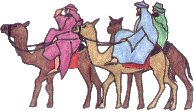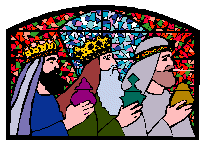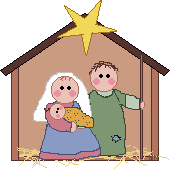Annie's Epiphany Page
![]()

"Now when
Jesus was born in Bethlehem of Judea in the days of Herod the
king, behold,
there came wise men from the east to Jerusalem, Saying, Where is
he that is born King
of the Jews? for we have seen his star in the east, and are come
to worship him."
~Matthew 2:1-2~
Epiphany in Greek means "manifestation".
Encyclopedia.com defines EPIPHANY
very simply:
"Epiphany [Gr., (=
(showing], a prime Christian feast, celebrated Jan. 6; also
called Twelfth Day or Little Christmas. It commemorates the
baptism of Jesus, the visit of the Wise Men to Bethlehem, and the
miracle of Cana. Its eve is Twelfth Night."
Epiphany is in the month of January

January
5th
is Twelfth Night. Evening before Epiphany. Marks end of the 12-day
season of Christmas festivities.
January 6th is Twelfth Day. The 12th
day after Christmas, when the three Wise Men visited Jesus.
Observed as Christmas in Spain and as Befana Day in Italy. Also called
Epiphany and Three Kings Day.
January 7th is the Orthodox Christmas
Day.
January 9th is the Feast of the
Baptism of the Lord celebrated by the Catholic Church

Here is what The World Book
Encyclopedia says about Epiphany:
"Epiphany,
pronounced ih PIHF uh nee, is a Christian festival. In Roman
Catholic and Protestant churches, Epiphany commemorates the
adoration of the infant Jesus by the Three Wise Men who had come
from the East. In Eastern churches, it celebrates the baptism of
Jesus. Epiphany comes from a Greek word that means to appear or
to show oneself."
Most Christians celebrate Epiphany on January 6, the 12th day
after Christmas. Roman Catholics in the United States observe the
festival on any Sunday from January 2 through January 8. During
Epiphany in Western churches, Biblical texts are read in church
that describe the various appearances of Jesus. The festival
commemorates the visit of the wise men from the East to the
infant Jesus. Epiphany, a Christian holiday, observes the visit
of the Magi to the baby Jesus, 12 days after Christmas. In
Eastern churches, the major observance is the blessing of
baptismal water. Some Eastern Christians observe this date as
Christmas, and Epiphany on January 19th.
![]()
From
Funk & Wagnall's Encyclopedia
"EPIPHANY (Gr. epiphaneia,
"appearance"), feast celebrated on
January 6 by the Anglican, Eastern, and Roman Catholic churches.
The feast originated, and is still recognized in the Eastern
Church, as the anniversary of the baptism of Christ. In the
Western churches, Epiphany commemorates principally the
revelation to the Gentiles of Jesus Christ as the Savior, as
portrayed by the coming of the Three Wise Men (see Matt. 2:1-12). In both the Eastern and
Western churches the feast secondarily commemorates the marriage
at Cana (see John 2:1-11), at which Christ
performed his first miracle. Epiphany, known to have been
observed earlier than AD 194, is older than Christmas and has
always been a festival of the highest rank. The eve of Epiphany
is called Twelfth Night, and the day itself is sometimes referred
to as Twelfth Day. In England, the sovereign commemorates the day
by offering gold, frankincense, and myrrh at the altar in the
Chapel Royal, at Saint James's Palace. In the Eastern church, at
Epiphany, the holy water is blessed, a ritual customarily taking
place on Holy Saturday (the day before Easter) in the Roman
Catholic church."
![]()
Definition
of Epiphany from Compton's Encyclopedia:
Epiphany (from
Greek epiphaneia, "appearance"), Christian festival
celebrated on January 6; one of the three principal and oldest
festival days of Christianity (including Easter and Christmas);
commemorates the first manifestation of Jesus to the Gentiles,
represented by the Magi, and the manifestation of his divinity,
as it occurred at his baptism in the Jordan River and at his
first miracle at Cana in Galilee; festival originated in the
Eastern Church; in the Western Church the festival primarily
commemorates the visit by the Magi to the infant Jesus; in the
East it primarily commemorates the baptism of Jesus
![]()
From MSN
Encarta Online:
"Epiphany, feast celebrated on January 6 by the Anglican,
Eastern, and Roman Catholic
churches. The feast originated in the Eastern Church where it is
still recognized as the
anniversary of the baptism of Jesus Christ. In the Western
churches, Epiphany
principally commemorates the revelation to the Gentiles of Jesus
Christ
as the Savior, as portrayed by the coming of the Three Wise
Men."
For more information about this visit: Annie's
Wisemen Page

What is the difference between the
Western & Eastern Church?
Ken Collins defines it this way: "Roughly
speaking, the western Church consists of Protestants, Catholics,
and Anglicans. The eastern Church consists of the Orthodox
churches, the Oriental churches, and the eastern-rite churches
affiliated with the Roman Catholic Church."
The Christmas season ends on Epiphany,
January 6. In Western Christian churches, Epiphany celebrates the
coming of the Wise Men to the Christ child. Among Eastern
Christians, this day celebrates Jesus' baptism. Epiphany falls on
the 12th day after Christmas. The song "The Twelve Days of
Christmas" refers to the 12 days between Christmas and
Epiphany.

Christmas & Epiphany Gift Giving Practices Around the World
from The World Book Encyclopedia & Comptons Encyclopedia
Gifts
on Epiphany: |
Gifts
on Christmas: |
| Puerto Rico: Puerto Ricans now celebrate such American holidays as July 4 and Memorial Day. Traditionally Christmas was celebrated on Three Kings Day (Epiphany, January 6). Since shops and television programs announce the arrival of Santa Claus on December 25, however, both days are celebrated. |
Ethopia: In Ethiopia, members of the Ethiopian Orthodox Church hold religious services on Christmas, January 7. The major celebration takes place nearly two weeks later at Epiphany. |
| Food for camels
instead of cookies for Santa: Youngsters in many Spanish-speaking nations have a similar custom. However, they leave the food for the camels of the Wise Men and put the shoes outside a window on the eve of Epiphany. The Magi place small gifts in the shoes during the night. The custom of hanging stockings by the fireplace probably developed from those traditions. |
La Befana: According to legend, the Wise Men asked the kindly old witch to accompany them to see the infant Jesus. She refused, saying she was too busy and had to clean her house, and so she missed the wondrous sight. Each year, La Befana goes from house to house, leaving gifts and looking for the Christ child. |
In
Spain: Traditionally, in some countries, such as Italy and Spain, children do not receive gifts until January 5, the eve of Epiphany. In Spain, children leave their shoes outside filled with straw and barley for the magi's animals and hope that presents will be left by the wise man Balthazar. As in the rest of Spain, most of the people are Roman Catholic, and the major city festivals celebrate saints' days. Twelve days after Christmas, on the feast of the Epiphany (the day the three wise men are said to have reached Bethlehem), a boat comes into the harbor bearing "three kings" who then parade through the streets. |
Italy: In Italy, La Befana brings presents on the eve of Epiphany. In Italy, most homes and churches have a presepio (Nativity scene). On Christmas Eve, the family prays while the mother places a figure of the Bambino (Christ child) in the manger. Many Italians serve eels for dinner on Christmas Eve. They also bake a Christmas bread called panettone, which contains raisins and candied fruit. Italian children receive gifts from La Befana, a kindly old witch, on the eve of Epiphany. Traditionally, in some countries, such as Italy and Spain, children do not receive gifts until January 5, the eve of Epiphany. According to Italian folklore, an old woman named Befana goes down chimneys and delivers presents to children on that night, just as the three wise men brought gifts to the infant Jesus. |



Here
is what the Compton's Encyclopedia says about the MAGI:
Magi
(plural of magus), from Persian magu, meaning magician; members
of a priestly caste of ancient Medes and Persians; name is
applied also to the wise men in the Bible (Matthew ii) who
followed a star to Bethlehem; the Bible story does not name them
nor give their number, but Christian tradition from about the 7th
century names the three Melchior, Gaspar, and Balthazar; their
bodies are said to have been brought to Constantinople by Empress
Helen, mother of Constantine, thence taken to Milan, and finally
to Cologne in 1162 by Frederick Barbarossa; since that time they
have often been called the Three Kings of Cologne
What does the Bible say about the
Magi or Wise Men?

I went to the Bible Study Tools site do do a search on
"Magi" in the King James
Bible and there were no verses listed. But I found 2 Study Tools
entries.
One from Nave's Topical Bible entry for "Magi" and found this:
The wise men from the east who visited Jesus as an infant Matthew 2:1-12
Smith's Bible Dictionary has a full page of
information about the "Magi".
So then I tried "wise men" and found 44 verses.
Nave's Topical Bible says this about the "Wise Men"
Of Egypt - Genesis 41:8,24; Exodus 7:11
Solomon - 1 Kings 4:29-34
Of Babylon - Daniel 4:18; 5:8
Other
Resource pages to see: Easton's Bible Dictionary has a page about Wise men
Smith's Bible Dictionary has a page about Wise men & Star of the wise men
![]()

![]()
When
is the REAL birthday of Jesus? Below is what the Compton's
Encyclopedia says:
"Because
there was no knowledge about the date of Jesus' birth, a day had
to be selected. The Eastern Orthodox and the Eastern Rite
churches within the Roman Catholic church chose January 6. The
day was named Epiphany, meaning "appearance," the day
of Jesus' manifestation. The Western church, based in Rome, chose
December 25. It is known from a notice in an ancient Roman
almanac that Christmas was celebrated on December 25 in Rome as
early as AD 336.
In the latter half of the 4th century, the Eastern and Western
churches adopted each other's festivals, thus establishing the
modern Christian 12-day celebration from Christmas to Epiphany.
In some places the 12th day is called the festival of the three
kings because it is believed that the three wise men, or magi,
visited the infant Jesus on that day, bringing Him gifts."
For more information about this visit: Annie's
Christmas History Page

Information
about the Manger or Creche from Compton's Encyclopedia:
Manger
scenes. A custom that originated in Southern Europe is the manger
scene, often referred to by its French name, creche. This is a
small model of the stable where Jesus was born, containing
figures of Mary, Joseph, the Infant, shepherds, farm animals, and
the three wise men and their gifts. Sometimes the wise men
figurines are put off to the side and moved a bit closer each day
after Christmas until they arrive at the scene on Epiphany.
The custom of recreating the Holy Night is said to have been
started by St. Francis of Assisi. On a Christmas Eve in 1224 he
is supposed to have set up a stable in a corner of a church in
his native village with real persons and animals to represent
those of the first Christmas.
Did you know that the Three Wisemen were not at the manger with
the shephards?
For more information about this visit: Annie's
Wisemen Page
EPIPHANY |
Miriam Webster Dictionary Listing for Epiphany:
Main Entry: epiph·a·ny
Pronunciation: i-'pi-f&-nE
Function: noun
Inflected Form(s): plural
-nies
Etymology: Middle English epiphanie, from
Middle French, from Late Latin epiphania, from
Late Greek, plural, probably alteration of Greek epiphaneia
appearance, manifestation, from epiphainein
to manifest, from epi- +
phainein to show -- more at FANCY (N)
Date: 14th century
1 capitalized
: January 6 observed as a church festival in commemoration of the
coming of the Magi as the first manifestation of Christ to the
Gentiles or in the Eastern Church in commemoration of the baptism
of Christ
2 : an appearance or manifestation especially of a divine being
3 a (1) : a usually sudden manifestation or perception of the
essential nature or meaning of something (2) : an intuitive grasp
of reality through something (as an event) usually simple and
striking (3) : an illuminating discovery b : a revealing scene or
moment.
Fine Arts Links "The Adoration of
the Magi" - by Fra Angelico Also
known as Giovanni da Related Artwork Links: With
the word "Baptism" in the Title. Bordone, Paris - The Baptism of
Christ, c. 1535/1540, oil on
canvas, Related Artwork Links: With
the word "Cana" in the Title. German
15th Century - A Lectern Cloth
with the Marriage at Cana, c. |

Epiphany is also a Literary Device.
Here is what The World Book Encyclopedia says about this use of
the word:
"Short-story
writers have developed a number of literary techniques, including
the surprise ending and epiphany. Most surprise endings involve
an unexpected event or a revealing explanation. Such endings were
the specialty of O. Henry, an American short-story writer of the
late 1800's and early 1900's. He used surprise endings in
"The Furnished Room" (1904), "The Gift of the
Magi" (1905), and many other tales. Epiphany is a sudden
comment, incident, or symbol that can be used at any point in a
story to explain the meaning of a complex event. James Joyce, an
Irish author of the early 1900's, created this technique. He
included it in a collection of short stories called Dubliners
(1914)."
Devotional & Meditation
Links: Wisemen
Pages: Send
a FREE Email Greeting Card: Related
Pages by Annie: For
January Holidays: |
Annie's
Featured Holiday Page |
Annie's
Featured Page |
Copyright
2000 - 2009 Annie's Home Page. All Rights Reserved.
I thank the Lord for graphics artists without them these pages
would not be the same.
Please visit Annie's List of Great
Graphics Spots for a list of their links. Sources:
The
World Book & Compton's Encyclopedia. Mini Joseph, Baby Jesus
and Mary Graphics are
from Cindy's Heartworks. This site hosted by: Christian Web Host